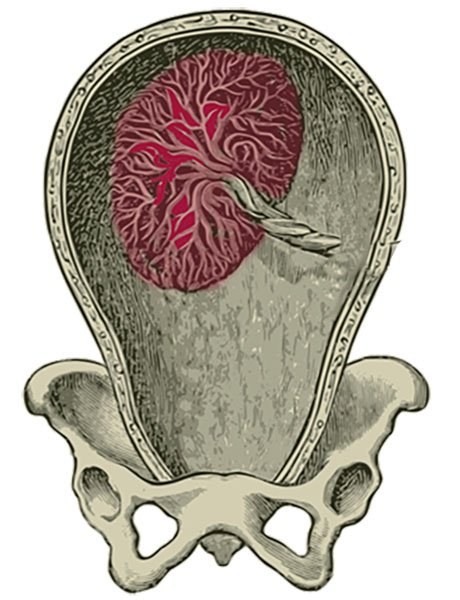
Retained placenta can be defined as lack of expulsion of the placenta within 30 minutes of birth of the baby, with all or part of the placenta remaining in the uterus. This condition, while not common, poses significant risks to the mother and must be treated promptly. Sometimes a piece of placenta is left behind in the uterus. If this happens, you may develop symptoms days or weeks after the birth. In this article, we’ll explore what retained placenta is, why it’s considered a medical emergency, the symptoms to watch for, and the treatments available.

What is a Retained Placenta?
A retained placenta occurs when the placenta, or parts of it, are not expelled from the uterus within 30 minutes after the baby is born. This condition can be categorized into three types:
- Placenta Adherens: The placenta remains attached to the uterine wall due to weak contractions.
- Trapped Placenta: The placenta detaches but becomes trapped behind a closed cervix.
- Placenta Accreta: The placenta attaches too deeply into the uterine wall, making separation difficult.
Why is Retained Placenta a Medical Emergency?
A retained placenta is considered a medical emergency for the following reasons:
- Haemorrhage: The most immediate danger is severe postpartum bleeding. A retained placenta can cause excessive blood loss, as it prevents the uterus from contracting and closing blood vessels. This leads to haemorrhagic shock, which is life-threatening if not treated promptly.
- Infection: Retained tissue in the uterus can become a breeding ground for bacteria, leading to infections such as endometritis. This is why the doctor or midwife will always check the placenta after delivery to ensure that it is complete. This condition can escalate quickly, causing high fever, severe pain, and potentially sepsis.
- Uterine Atony: The uterus fails to contract properly, exacerbating bleeding and increasing the risk of haemorrhage.
- Sepsis: Severe infection can lead to sepsis, a life-threatening response to infection.
Symptoms of a Retained Placenta
During the third stage of labour, the placenta separates from the wall of the uterus. The placenta and membranes that supported the baby in the uterus during pregnancy are then expelled through the vagina. So complete retention of the placenta is obvious and may be accompanied by heavy bleeding.
Recognizing the symptoms of part of the placenta being retained is vital for timely medical intervention.
Close examination of the placenta may show that it is not complete. Sometimes a piece of placenta is left behind in the uterus. If this happens, you may develop symptoms days or weeks after the birth.
If not recognised at this stage, then later symptoms may include –
- Excessive bleeding
- Prolonged bleeding beyond normal postpartum period
- Severe abdominal pain
- Fever and chills
- Foul-smelling vaginal discharge

Treatment Options
Treating a retained placenta requires immediate medical intervention to prevent severe complications. Common treatments include:
- Manual Removal: If the complete placenta remains within the uterus, the doctor will need to manually remove it. This procedure is usually performed under anaesthesia.
- Surgical Intervention: In some cases, a surgical procedure known as curettage (D&C) might be necessary to remove placental fragments.
- Antibiotics: If an infection is present or likely, antibiotics are prescribed to prevent or treat bacterial infections.
Preventive Measures
Preventive strategies during pregnancy and labour can reduce the risk of retained placenta. These include:
- Regular prenatal care to monitor placental health
- Adequate management of labour and delivery, including timely administration of uterotonic drugs if needed
- In most hospital units, the third stage is ‘actively managed’ as there is less risk of significant blood loss at delivery. However, you may choose a physiological, ‘unaided’ third stage. During an actively managed third stage: you’ll have an injection to reduce the size of your womb, then when there is sign of the placenta separating, the doctor or midwife will use gentle cord traction to deliver the placenta.
- Close observation of the mother and baby during the third stage of labour to ensure complete expulsion of the placenta
Conclusion
Retained placenta is a serious medical condition that requires immediate attention. Understanding the risks, recognizing symptoms, and knowing the treatment options can help ensure the safety and well-being of the mother. If you suspect a retained placenta after childbirth, seek medical help immediately to prevent complications and ensure a swift recovery.

RECENT POSTS
- The Differences in a Twin Pregnancy: What You Need to Know
- What is the significance of bleeding at different stages of pregnancy?
- How to Cope with Claustrophobia: Effective Strategies for Managing Anxiety
- 50 Great Bible Quotes Relating to Pregnancy
- 10 Tips for Getting a Baby to Sleep
- How Much Sleep Does a Baby Need? A Comprehensive Guide for New Parents
- How to Make Money with ChatGPT: A Comprehensive Guide
- Unexplained Infertility: What Can You Do. Advice and Guidance
- The Benefits of Mindfulness: A Practical Guide to a Healthier and Happier Life
- Constipation During Pregnancy: Causes, Prevention, and Relief
- Pregnancy Myths, Superstitions, and Old Wives’ Tales: Fact or Fiction
- Endometriosis: The Impact on Fertility and Pregnancy
- Disabled and Pregnant: Equality Problems and Solutions
- Meconium Clinical Significance and Warning Signs
- Hypnosis in Pregnancy and Delivery: A Comprehensive Guide
- Pregnancy Tests: What is Amniocentesis? Your Complete Guide.
- Study at Home for a New Job or New Career: Your Path to Success
- What is Advanced Maternal Age?
- Essential Guide to Changes in Pregnancy
- Buying for a New Baby: The Essentials
Leave a Reply